Gigabyte Z77X-UP7 Review: OC Oriented Orange Overkill
by Ian Cutress on March 1, 2013 10:30 AM EST- Posted in
- Motherboards
- Intel
- Gigabyte
- Z77
Dealing with PLX 8747 Chips and PCIe Lane Layouts
The Z77 chipset specification allows Ivy Bridge CPUs to utilize the 16 PCIe 3.0 lanes in very specific layouts – x16, x8/x8, or x8/x4/x4. In order to do anything else (including 4-way), we have to put in a PCIe 3.0 switch – and the one in use on motherboards that want this functionality is the PLX 8747, which we covered in great detail back in August 2012. The upside of this chip is that for 8 or 16 lanes in, we get 32 lanes out, which can be distributed however the motherboard manufacturer wants. The downside of using this chip however is a small amount of overhead, causing a minor drop in frame rates. For the Gigabyte Z77X-UP7, we get the following configuration:
The UP7 involves a switch which allows the user to have access to a single PCIe 3.0 x16 slot without even touching the PLX chip. However the moment the user wants to add in another card, we can migrate to the orange slots via the PLX chip and maximize the bandwidth it offers. This gives five different configurations:
One card: x16 or x16 via PLX
Two card: x16/x16 via PLX
Three card: x8/x8/x16 via PLX
Four card: x8/x8/x8/x8
In this review I used the opportunity to look at our normal benchmark suite and see how much overhead the PLX chip actually affords to the motherboards that use it.
Metro2033
Metro2033 is a DX11 benchmark that challenges every system that tries to run it at any high-end settings. Developed by 4A Games and released in March 2010, we use the inbuilt DirectX 11 Frontline benchmark to test the hardware at 2560x1440 with full graphical settings. Results are given as the average frame rate from 4 runs.
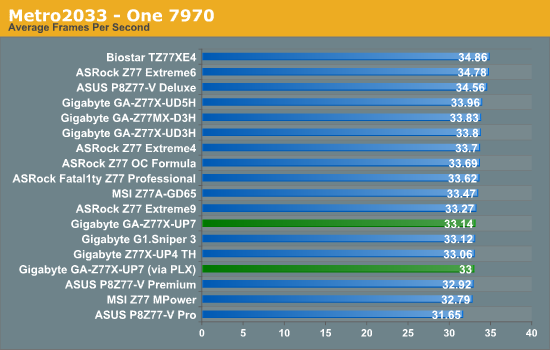
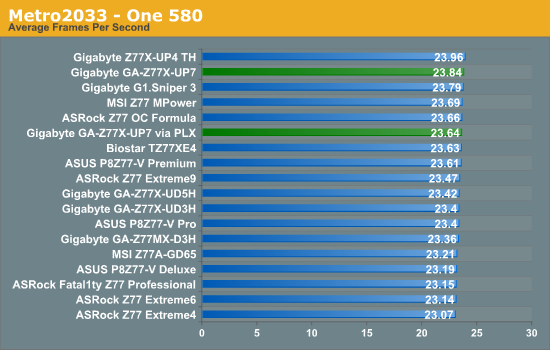
On the PLX front, the chip reduced the single AMD frame rate from 33.14 FPS to 33.00 FPS, a 0.415% decrease. On the NVIDIA side, it reduced our frame rate from 23.84 FPS to 23.64 FPS, a 0.839% decrease. Both of these are nothing much to shout about, especially given the previous NF200 on X58 was a decrease of ~2% performance. Compared to other Z77 motherboards, the UP7 takes advantage of the efficiency we saw in the CPU throughput benchmarks.
Dirt 3
Dirt 3 is a rallying video game and the third in the Dirt series of the Colin McRae Rally series, developed and published by Codemasters. Using the in game benchmark, Dirt 3 is run at 2560x1440 with Ultra graphical settings. Results are reported as the average frame rate across four runs.
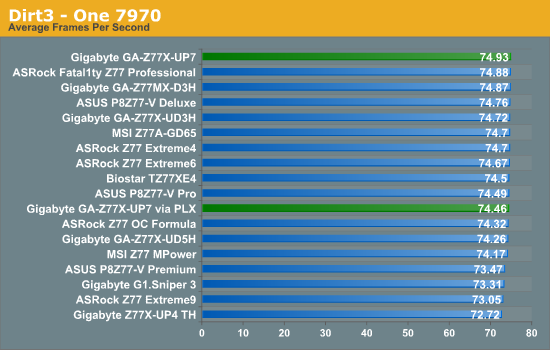
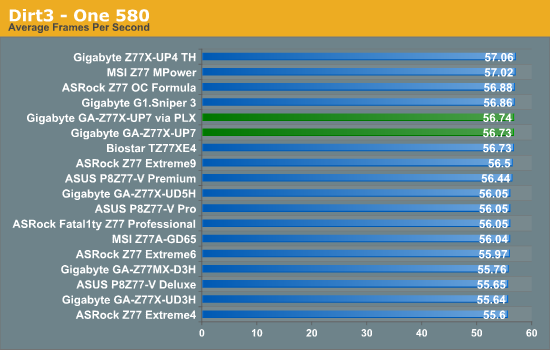
Again the PLX chip causes a minor hit to overall performance, as shown by the 1.97% drop on single card AMD (74.93 FPS to 73.46 FPS), but not so on NVIDIA (56.73-56.74 FPS) both with and without the PLX.
Other Benchmarks
As part of an upcoming update in our motherboard testing, we are moving towards newer drivers, and adding another couple of games to the test bed – Civilization V and Sleeping Dogs, both at 2560x1440 and all the graphical options turned right up. As we are not complete with this testing, we do not have any substantial tables to look through, though I do have Single GPU results on Catalyst 13.1 and NVIDIA 310.90 drivers for these games:
Civilization V:
- 86.43 FPS on HD7970
- 81.62 FPS on HD7970 via PLX
- 82.22 FPS on GTX580
- 80.40 FPS on GTX580 via PLX
Sleeping Dogs:
- 28.20 FPS on HD7970
- 27.98 FPS on HD7970 via PLX
- 16.10 FPS on GTX580
- 16.05 FPS on GTX580 via PLX
On all fronts the PLX chip causes a minor hit:
- Civ V: 5.57% on HD7970, 2.21% on GTX580
- Sleeping Dogs: 0.80% on HD7970, 0.31% on GTX580


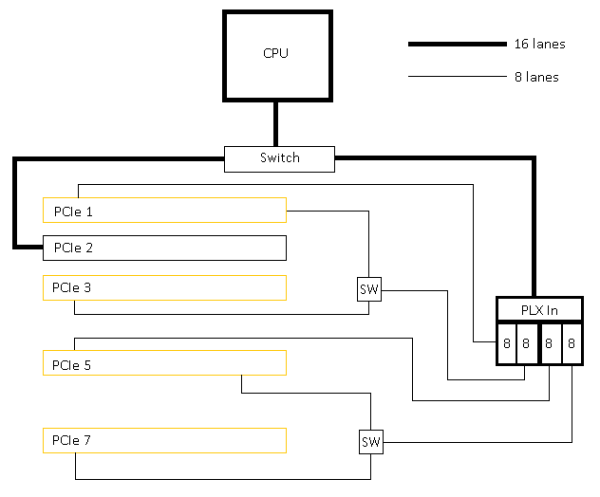








41 Comments
View All Comments
madmilk - Friday, March 1, 2013 - link
You're not going to find what you want in a 7-slot ATX form factor. However, dropping down your x16 GPU requirement makes possible with water cooling and a good X79 motherboard.Moving up to Xeon opens up some more options. One is this: http://www.avadirect.com/tower-server-configurator... Real PCIe 3.0 x16 Quad-SLI, plus two more PCIe 3.0 x8 and one PCIe 2.0 x4.
Getting those last PCIe lanes is very, very expensive, and completely worthless for anything but GPU compute.
JeBarr - Saturday, March 2, 2013 - link
I'm hoping for a few new motherboards with the next enthusiast platform refresh. Ideally 10 slot to make room for all the expansion cards a gamer geek could possibly use :DSamus - Friday, March 1, 2013 - link
Can you use all 5 pcie x16 slots simultaneously with single-slot GPU's, obviously not in SLI?Samus - Friday, March 1, 2013 - link
You answered my question above, thanks!sherlockwing - Friday, March 1, 2013 - link
You said:If Gigabyte was going for more sales, from my perspective, if some of the IR3550s were removed and the system reduced to just over $300, it might get more takers
What Gigabyte does have on the market is the http://detonator.dynamitedata.com/cgi-bin/redirect...">UP5-TH for about $250.
It have the exact same PWM chip in the VRM as the UP7 (8 phase IR3563), only that UP7 runs it through a quadrupler for 32 VRM phase while UP5 don't use any so it runs only 8 IR3550 but 8*60= 480A is already overkill for Ivy Bridge.
The only other thing UP5-TH misses other than VRM phase overkill is the PLX chip, so it can't run 4 way SLI/CLX, and can only run 3 way at 8X/4X/4X. But for people running 2 cards or less it is more than enough.
UP7 is a halo product/ultra flagship just like the GTX Titan, UP-5TH is the mainstream Flagship.
IanCutress - Friday, March 1, 2013 - link
Yup, we reviewed the UP4 TH: http://www.anandtech.com/show/6296/Though that goes along their Thunderbolt line. The Thunderbolt controller isn't cheap. But as mentioned the comparison is the G1.Sniper 3 with the PLX, or the Z77X-UD5H without the PLX (or Thunderbolt).
Ian
mayankleoboy1 - Friday, March 1, 2013 - link
Y U no use WinRAR 4.2 ?Its much better multithreaded.
IanCutress - Friday, March 1, 2013 - link
To maintain consistency with the last 18 months of benchmark results ;) Should probably do an update for Haswell later this year though.Ian
Kevin G - Friday, March 1, 2013 - link
For a user putting down $400 for a motherboard, especially one aimed at overclocking and high performance, why not go the LGA 2011 route and X79? In this price range, LGA-1155 and Z77 just don't seem to be premium products in comparison.baberpervez - Friday, March 1, 2013 - link
Why in the world is Gigabyte focusing on the LG1366 market? With all new cpus being LG1155 or 2011, seems counterproductive to produce a unit for an older motherboard kind. Even with my I7 960 I don' tknow why anyone would want to upgrade to this product. With triple -SLI (570s) a fourth slot is useless since the cards are only 3 way capable, but definitely worth experiementing on for 480's/580s/680s.The price is what it is, very hefty...and only serious overclockers would want to purchase this.
If Nvidia made the 570 quad sli than I would consider getting this, but there's no chance of me replacing three cards to go into a higher configuration anytime soon.
This board would have done very well a few years ago...
Just not convinced LG1366 was a good idea.